technical data SKODA OCTAVIA TOUR 2011 2.G / (1Z) Workshop Manual
[x] Cancel search | Manufacturer: SKODA, Model Year: 2011, Model line: OCTAVIA TOUR, Model: SKODA OCTAVIA TOUR 2011 2.G / (1Z)Pages: 183, PDF Size: 11.13 MB
Page 102 of 183
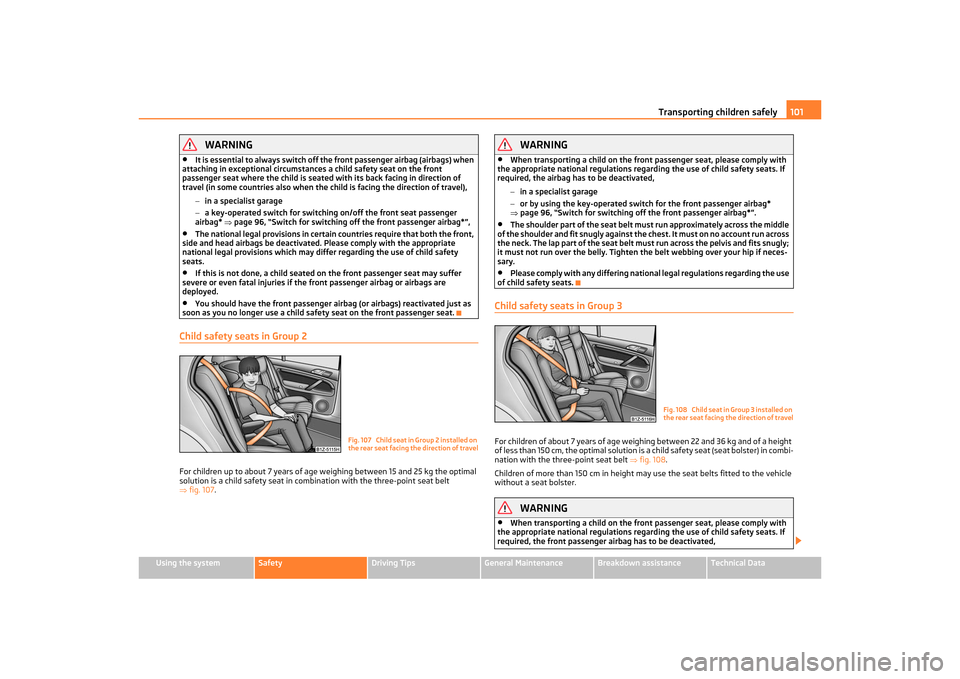
Transporting children safely101
Using the system
Safety
Driving Tips
General Maintenance
Breakdown assistance
Technical Data
WARNING
•
It is essential to always switch off the front passenger airbag (airbags) when
attaching in exceptional circumstances a child safety seat on the front
passenger seat where the child is seated with its back facing in direction of
travel (in some countries also when the child is facing the direction of travel),
−in a specialist garage
− a key-operated switch for switching on/off the front seat passenger
airbag* page 96, “Switch for switching off the front passenger airbag*”,
•
The national legal provisions in certain countries require that both the front,
side and head airbags be deactivated. Please comply with the appropriate
national legal provisions which may diffe r regarding the use of child safety
seats.
•
If this is not done, a child seated on the front passenger seat may suffer
severe or even fatal injuries if the front passenger airbag or airbags are
deployed.
•
You should have the front passenger airb ag (or airbags) reactivated just as
soon as you no longer use a child safe ty seat on the front passenger seat.
Child safety seats in Group 2For children up to about 7 years of age we ighing between 15 and 25 kg the optimal
solution is a child safety seat in combination with the three-point seat belt
fig. 107 .
WARNING
•
When transporting a child on the front passenger seat, please comply with
the appropriate national regulations regard ing the use of child safety seats. If
required, the airbag has to be deactivated,
− in a specialist garage
− or by using the key-operated switch for the front passenger airbag*
page 96, “Switch for switching off the front passenger airbag*”.
•
The shoulder part of the seat belt mu st run approximately across the middle
of the shoulder and fit snugly against the chest. It must on no account run across
the neck. The lap part of the seat belt mu st run across the pelvis and fits snugly;
it must not run over the belly. Tighten the belt webbing over your hip if neces-
sary.
•
Please comply with any differing natio nal legal regulations regarding the use
of child safety seats.
Child safety seats in Group 3For children of about 7 years of age weighing between 22 and 36 kg and of a height
of less than 150 cm, the optimal solution is a child safety seat (seat bolster) in combi-
nation with the three-point seat belt fig. 108 .
Children of more than 150 cm in height ma y use the seat belts fitted to the vehicle
without a seat bolster.
WARNING
•
When transporting a child on the front passenger seat, please comply with
the appropriate national regulations regard ing the use of child safety seats. If
required, the front passenger ai rbag has to be deactivated,
Fig. 107 Child seat in Group 2 installed on
the rear seat facing the direction of travel
Fig. 108 Child seat in Group 3 installed on
the rear seat facing the direction of travel
s2lk.2.book Page 101 Monday, April 18, 2011 7:41 AM
Page 104 of 183
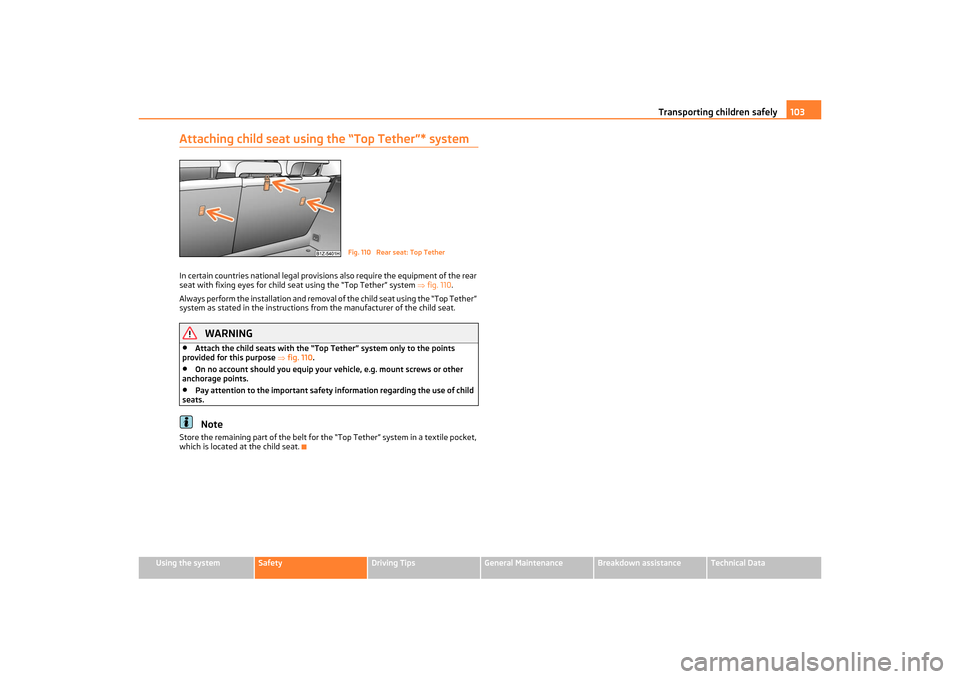
Transporting children safely103
Using the system
Safety
Driving Tips
General Maintenance
Breakdown assistance
Technical Data
Attaching child seat using the “Top Tether”* systemIn certain countries national legal provisions also require the eq uipment of the rear
seat with fixing eyes for child seat using the “Top Tether” system fig. 110 .
Always perform the installation and removal of the child seat using the “Top Tether”
system as stated in the instructions from the manufacturer of the child seat.
WARNING
•
Attach the child seats with the “Top Tether” system only to the points
provided for this purpose fig. 110 .
•
On no account should you equip your vehicle, e.g. mount screws or other
anchorage points.
•
Pay attention to the important safety information regarding the use of child
seats.Note
Store the remaining part of the belt for the “Top Tether” system in a textile pocket,
which is located at the child seat.
Fig. 110 Rear seat: Top Tether
s2lk.2.book Page 103 Monday, April 18, 2011 7:41 AM
Page 106 of 183
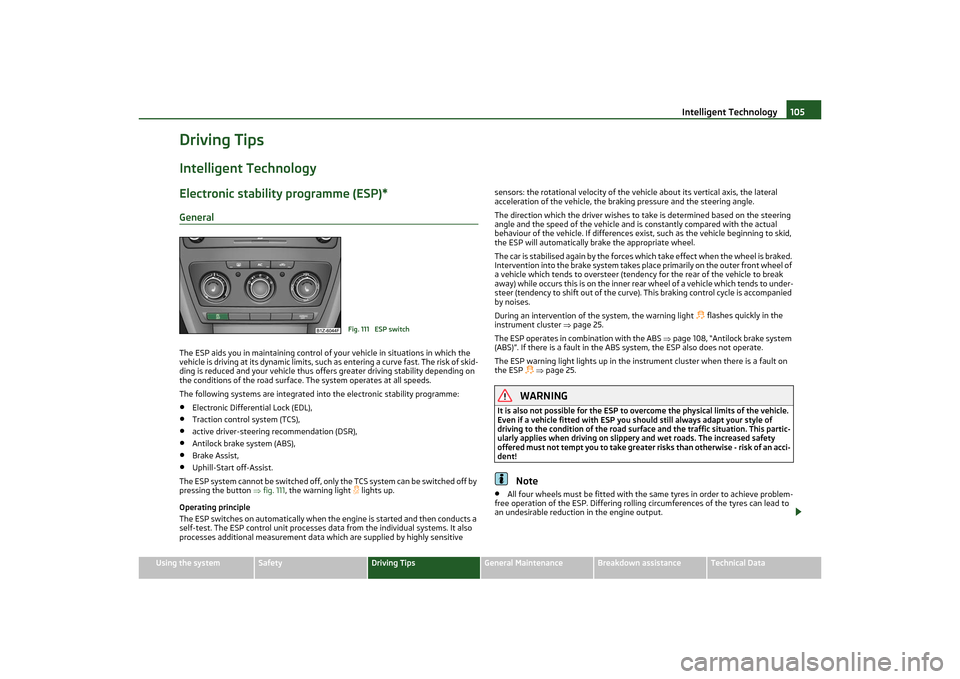
Intelligent Technology105
Using the system
Safety
Driving Tips
General Maintenance
Breakdown assistance
Technical Data
Driving TipsIntelligent TechnologyElectronic stability programme (ESP)*GeneralThe ESP aids you in maintaining control of your vehicle in situations in which the
vehicle is driving at its dynamic limits, such as entering a curve fast. The risk of skid-
ding is reduced and your vehicle thus offers greater driving stability depending on
the conditions of the road surface. The system operates at all speeds.
The following systems are integrated into the electronic stability programme:•
Electronic Differential Lock (EDL),
•
Traction control system (TCS),
•
active driver-steering recommendation (DSR),
•
Antilock brake system (ABS),
•
Brake Assist,
•
Uphill-Start off-Assist.
The ESP system cannot be switched off, only the TCS system can be switched off by
pressing the button fig. 111 , the warning light
lights up.
Operating principle
The ESP switches on automatically when th e engine is started and then conducts a
self-test. The ESP control unit processes data from the individual systems. It also
processes additional measurement data which are supplied by highly sensitive sensors: the rotational velocity of the ve
hicle about its vertical axis, the lateral
acceleration of the vehicle, the braking pressure and the steering angle.
The direction which the driver wishes to take is determined based on the steering
angle and the speed of the vehicle and is constantly compared with the actual
behaviour of the vehicle. If differences exist, such as the vehicle beginning to skid,
the ESP will automatically brake the appropriate wheel.
The car is stabilised again by the forces which take effect when the wheel is braked.
Intervention into the brake system takes pl ace primarily on the outer front wheel of
a vehicle which tends to oversteer (tendency for the rear of the vehicle to break
away) while occurs this is on the inner re ar wheel of a vehicle which tends to under-
steer (tendency to shift out of the curve). This braking control cycle is accompanied
by noises.
During an intervention of the system, the warning light
flashes quickly in the
instrument cluster page 25.
The ESP operates in combination with the ABS page 108, “Antilock brake system
(ABS)”. If there is a fault in the ABS system, the ESP also does not operate.
The ESP warning light lights up in the instrument cluster when there is a fault on
the ESP
page 25.
WARNING
It is also not possible for the ESP to over come the physical limits of the vehicle.
Even if a vehicle fitted with ESP you sh ould still always adapt your style of
driving to the condition of the road surfac e and the traffic situation. This partic-
ularly applies when driving on slippery and wet roads. The increased safety
offered must not tempt you to take greate r risks than otherwise - risk of an acci-
dent!
Note
•
All four wheels must be fitted with the same tyres in order to achieve problem-
free operation of the ESP. Differing rolling circumferences of the tyres can lead to
an undesirable reduction in the engine output.
Fig. 111 ESP switch
s2lk.2.book Page 105 Monday, April 18, 2011 7:41 AM
Page 108 of 183

Intelligent Technology107
Using the system
Safety
Driving Tips
General Maintenance
Breakdown assistance
Technical Data
Switching off
You can switch the TCS off and on again as you wish by pressing the button
page 106, fig. 112 . The TCS warning light lights up in the instrument cluster when
the TCS is switched off
page 25.
The TCS should normally always be switched on. It may be good practice in certain
exceptional cases, such as when you wish to have wheel slip, to switch off the
system.
Examples:
•
when driving with snow chains
•
when driving in deep snow or on a loose surface
•
when it is necessary to rock a vehicle when it has become stuck.
then you should switch on the TCS again.
WARNING
You should always adjust your style of driving to the conditions of the road
surface and the traffic situation. The in creased safety offered must not tempt
you to take greater risks than ot herwise - risk of an accident!
Note
•
All four wheels must be fitted with the same tyres in order to achieve problem-
free operation of the TCS. Differing rolling circumferences of the tyres can lead to
an undesirable reduction in the engine output.
•
Changes to vehicle (e.g. on engine, on the brakes, on chassis or another combi-
nation of tyres and wheels) can influence the function of the TCS page 146,
“Accessories, changing and replacing parts”.
Active driver-steerin g recommendation (DSR)*Vehicles with ESP are equipped with active driver-steering recommendation (DSR).
This function indicates to the driver in critical situations a steering recommendation
in order to stabilise the vehicle. The active driver-steering recommendation is acti-
vated, for example, on the right and left vehicle side when braking sharply on
different road surfaces.
WARNING
Even with this function the vehicle cannot steer itself! The driver is furthermore
responsible for the steering of the vehicle!BrakesWhat has a negative effect on braking efficiency?Wear-and-tear
Wear-and-tear to the brake pads is greatly dependent on the operating conditions
of the vehicle and your style of driving. Particularly if you drive a great deal in towns
and over short distances or if you adopt a sp orty style of driving, it may be necessary
to have the thickness of the brake pads inspected at a specialist garage between
the service inspections.
Wet roads or road salt
There may be a certain delay before the brakes take full effect under certain condi-
tions such as when driving through water, during heavy rain showers or after the
vehicle has been washed in an automatic vehicle wash, since the brake discs and
brake pads may be moist or even have a coating of ice on them in winter. You should
dry the brakes as soon as possible by applying and releasing the brakes several
times.
There also may be a certain delay before the full braking efficiency is available when
driving on roads which have been treated wi th road salt if you have not used the
brakes for some considerable time beforehand. The layer of salt on the brake discs
and brake pads must first be rubbed off when you apply the brakes.
Corrosion
Corrosion on the brake discs and dirt on the bake pads occur if the vehicle has been
parked for a long period and if you do not make much use of the braking system.
We recommend cleaning the brake discs by firmly applying the brakes at a fairly high
speed if you do not make much use of the braking system or if surface corrosion is
present .
Faults in the brake surface
If you notice that the braking distance has suddenly become longer and that the
brake pedal can be depressed further, it is possible that a brake circuit of the dual-
circuit brake system has failed. Drive, in such cases, to the nearest specialist garage
without delay in order to have the problem rectified. Drive at a reduced speed while
on your way to the dealer and adapt your style of driving to the higher brake pedal
pressure required.
s2lk.2.book Page 107 Monday, April 18, 2011 7:41 AM
Page 110 of 183
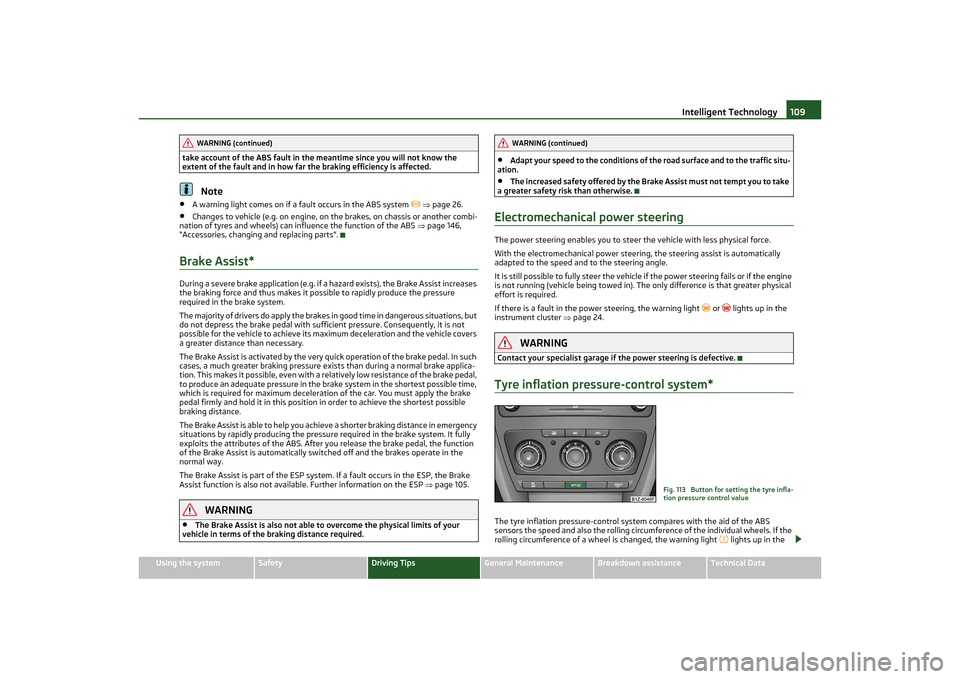
Intelligent Technology109
Using the system
Safety
Driving Tips
General Maintenance
Breakdown assistance
Technical Data
take account of the ABS fault in the meantime since you will not know the
extent of the fault and in how far
the braking efficiency is affected.
Note
•
A warning light comes on if a fault occurs in the ABS system
page 26.
•
Changes to vehicle (e.g. on engine, on the brakes, on chassis or another combi-
nation of tyres and wheels) can influence the function of the ABS page 146,
“Accessories, changing and replacing parts”.
Brake Assist*During a severe brake application (e.g. if a hazard exists), the Brake Assist increases
the braking force and thus makes it possible to rapidly produce the pressure
required in the brake system.
The majority of drivers do apply the brakes in good time in dangerous situations, but
do not depress the brake pedal with sufficient pressure. Consequently, it is not
possible for the vehicle to achieve its maximum deceleration and the vehicle covers
a greater distance than necessary.
The Brake Assist is activated by the very quick operation of the brake pedal. In such
cases, a much greater braking pressure exists than during a normal brake applica-
tion. This makes it possible, even with a relatively low resistance of the brake pedal,
to produce an adequate pressure in the brake system in the shortest possible time,
which is required for maximum deceleration of the car. You must apply the brake
pedal firmly and hold it in this position in order to achieve the shortest possible
braking distance.
The Brake Assist is able to help you achi eve a shorter braking distance in emergency
situations by rapidly producing the pressure required in the brake system. It fully
exploits the attributes of the ABS. After you release the brake pedal, the function
of the Brake Assist is automatically swit ched off and the brakes operate in the
normal way.
The Brake Assist is part of the ESP system. If a fault occurs in the ESP, the Brake
Assist function is also not availa ble. Further information on the ESP page 105.
WARNING
•
The Brake Assist is also not able to overcome the physical limits of your
vehicle in terms of the braking distance required.
•
Adapt your speed to the conditions of th e road surface and to the traffic situ-
ation.
•
The increased safety offered by the Brake Assist must not tempt you to take
a greater safety risk than otherwise.
Electromechanical power steeringThe power steering enables you to steer the vehicle with less physical force.
With the electromechanical power steering, the steering assist is automatically
adapted to the speed and to the steering angle.
It is still possible to fully steer the vehicle if the power steering fails or if the engine
is not running (vehicle being towed in). The only difference is that greater physical
effort is required.
If there is a fault in the power steering, the warning light
or lights up in the
instrument cluster page 24.
WARNING
Contact your specialist garage if the power steering is defective.Tyre inflation pressure-control system*The tyre inflation pressure-control system compares with the aid of the ABS
sensors the speed and also the rolling circumference of the individual wheels. If the
rolling circumference of a wheel is changed, the warning light
lights up in the
WARNING (continued)
WARNING (continued)
Fig. 113 Button for setting the tyre infla-
tion pressure control value
s2lk.2.book Page 109 Monday, April 18, 2011 7:41 AM
Page 112 of 183
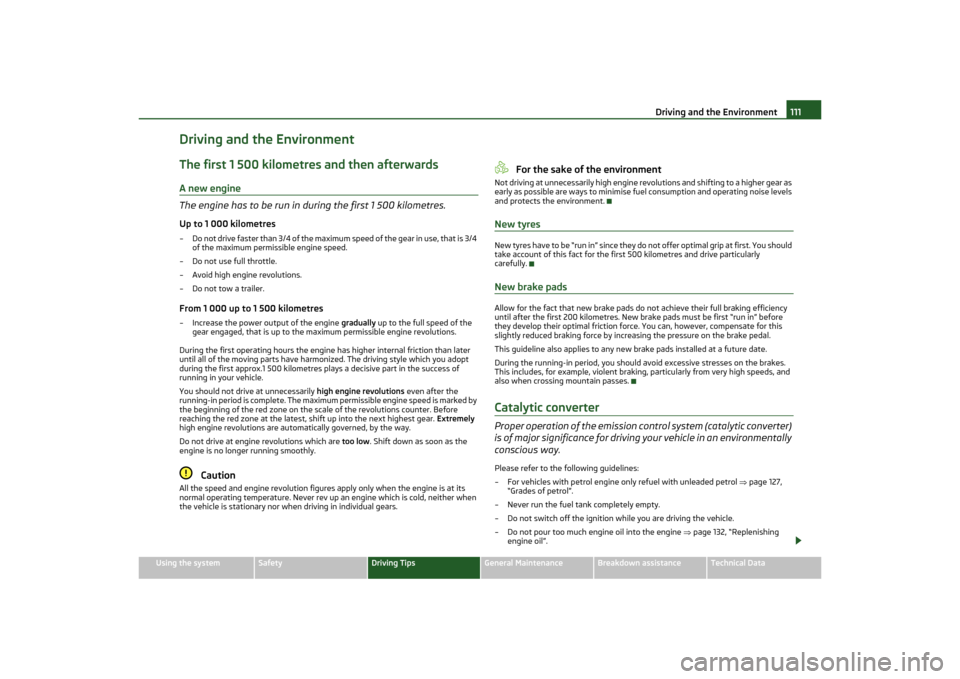
Driving and the Environment111
Using the system
Safety
Driving Tips
General Maintenance
Breakdown assistance
Technical Data
Driving and the EnvironmentThe first 1 500 kilometres and then afterwardsA new engine
The engine has to be run in during the first 1 500 kilometres.Up to 1 000 kilometres– Do not drive faster than 3/4 of the maximum speed of the gear in use, that is 3/4
of the maximum permissible engine speed.
– Do not use full throttle.
– Avoid high engine revolutions.
– Do not tow a trailer.From 1 000 up to 1 500 kilometres– Increase the power output of the engine gradually up to the full speed of the
gear engaged, that is up to the maximum permissible engine revolutions.
During the first operating hours the engine has higher internal friction than later
until all of the moving parts have harmonized. The driving style which you adopt
during the first approx.1 500 kilometres plays a decisive part in the success of
running in your vehicle.
You should not drive at unnecessarily high engine revolutions even after the
running-in period is complete. The maximum permissible engine speed is marked by
the beginning of the red zone on the sc ale of the revolutions counter. Before
reaching the red zone at the latest, shift up into the next highest gear. Extremely
high engine revolutions are auto matically governed, by the way.
Do not drive at engine revolutions which are too low. Shift down as soon as the
engine is no longer running smoothly.
Caution
All the speed and engine revolution figures apply only when the engine is at its
normal operating temperature. Never rev up an engine which is cold, neither when
the vehicle is stationary nor when driving in individual gears.
For the sake of the environment
Not driving at unnecessarily high engine revo lutions and shifting to a higher gear as
early as possible are ways to minimise fu el consumption and operating noise levels
and protects the environment.New tyresNew tyres have to be “run in” since they do not offer optimal grip at first. You should
take account of this fact for the firs t 500 kilometres and drive particularly
carefully.New brake padsAllow for the fact that new brake pads do not achieve their full braking efficiency
until after the first 200 kilometres. New br ake pads must be first “run in” before
they develop their optimal friction force. You can, however, compensate for this
slightly reduced braking force by increasing the pressure on the brake pedal.
This guideline also applies to any new brake pads installed at a future date.
During the running-in period, you should avoid excessive stresses on the brakes.
This includes, for example, violent braking, particularly from very high speeds, and
also when crossing mountain passes.Catalytic converterProper operation of the emission control system (catalytic converter)
is of major significance for driving your vehicle in an environmentally
conscious way.Please refer to the following guidelines:
– For vehicles with petrol engine only refuel with unleaded petrol page 127,
“Grades of petrol”.
– Never run the fuel tank completely empty.
– Do not switch off the ignition while you are driving the vehicle.
– Do not pour too much engine oil into the engine page 132, “Replenishing
engine oil”.
s2lk.2.book Page 111 Monday, April 18, 2011 7:41 AM
Page 114 of 183

Driving and the Environment113
Using the system
Safety
Driving Tips
General Maintenance
Breakdown assistance
Technical Data
Shifting gears and saving energy
Shifting up early saves on fuel.– Drive no more than about one leng th of your vehicle in first gear.
– Always shift up into the next higher gear at approx. 2 000 to 2 500 revs.
An effective way of achieving good fuel economy is to shift up early. You will
consume more fuel if you drive at unnecessarily high revolutions in any given gear.
The fig. 114 shows the ratio of fuel consumption to the speed of your vehicle in
the relevant gears. Fuel consumption in 1st gear is the highest, while that in 5th or
the 6th gear is the lowest.
Note
Also use the information supplied by the multi-functional indicator* page 18.
Avoiding full throttle
Driving more slowly means saving fuel.Sensitive use of the accelerator will not only significantly reduce fuel consumption
but also positively influence environmental pollution and wear of your vehicle.
You should avoid exploiting the top speed of your vehicle wherever possible. Fuel
consumption, pollutant emissions and vehicl e noises increase disproportionally at
high speeds.
The fig. 115 shows the ratio of fuel consumption to the speed of your vehicle. You
will cut your fuel consumption by half if you only make use three-quarters of the
possible top speed of your vehicle.Reducing idling
Idling also costs fuel.It is worthwhile switching off the engine in a traffic jam or when waiting at a level
crossing or at traffic lights with a lengthy red phase. Even after just 30 - 40 seconds
you will have saved more fuel than that is needed when you start the engine up
again.
If an engine is only idling it takes much longer for it to reach its normal operating
temperature. Wear-and-tear and pollutant em issions, though, are particularly high
in the warming-up phase. This is why you should drive off right after starting the
engine. Do avoid high engine revolutions at this time, however.
Fig. 114 Fuel consumption in litres/100
km. and speed in km/h.
Fig. 115 Fuel consumption in litres/100
km. and speed in km/h.
s2lk.2.book Page 113 Monday, April 18, 2011 7:41 AM
Page 116 of 183

Driving and the Environment115
Using the system
Safety
Driving Tips
General Maintenance
Breakdown assistance
Technical Data
No unnecessary ballast
Transporting ballast costs fuel.The fact that every kilogram of extra weight increases your fuel consumption
means that it is worth taking a look in the luggage compartment to avoid trans-
porting any unnecessary ballast.
It is particularly in town traffic, when one is accelerating quite often, that the vehicle
weight will have a significant effect upon the fuel consumption. A rule of thumb
here is that an increase in weight of 1 00 kilograms will cause an increase in fuel
consumption of about 1 litre/100 kilometres.
You may frequently also leave a roof rack fitted on just out of convenience,
although you no longer need it. The increased aerodynamic drag of your vehicle
causes it to use about 10 % more fuel than normal at a speed of 100 - 120 km/h, even
when you are not carrying a load on the roof.Saving electricity
Generating electricity costs fuel.– Switch off electrical components as soon as you no longer need them.
When the engine is running, the alternator generates and supplies electrical power.
The greater the load on the alternator as a result of having a large number of elec-
trical components switched on, the more fuel will be consumed for operating the
alternator.Keeping a log of your fuel consumptionIf you really wish to keep a close check on your fuel consumption, it is best to enter
the figures in a logbook. This does not take much time but is a very worthwhile exer-
cise. It enables you to detect any change (positive and negative) at an early stage
and to take any appropriate action.
If you find that your fuel consumption is too high, you should reflect on how, where
and in what conditions you have driven the vehicle since you last refuelled.Environmental compatibilityEnvironmental protection has played a major role in the design, selection of mate-
rials and manufacture of your new Škoda. Particular emphasis has been paid to a
number of aspects, including: Design measures
•
Joints designed to be easily detached.
•
Simplified disassembly due to the modular structure system.
•
Improved purity of differ
ent classes of materials.
•
Identification of all plastic parts in accordance with VDA Recommendation°260.
•
Reduced fuel consumption and exhaust emission CO
2.
•
Minimum fuel leakage during accidents.
•
Reduced noise.
Choice of materials
•
Extensive use of recyclable material.
•
Air conditioning filled with CFC-free refrigerant.
•
No cadmium.
•
No asbestos.
•
Reduction in the “vaporisation” of plastics.
Manufacture
•
Solvent-free cavity protection.
•
Solvent-free protection of the vehicle fo r transportation from the production
plant to the customer.
•
The use of solvent-free adhesives.
•
No CFCs used in the production process.
•
Without use of mercury.
•
Use of water-soluble paints.
Trade-in and recycling of old cars
Škoda Auto meets the requirements of th e brand and its products regarding envi-
ronment and resource protection. All new Škoda vehicles can be utilized up to 95 %
and always
5) be returned. In a lot of countries sufficient trade-in networks have
been created, where you can trade-in your vehicle. After you trade-in your vehicle,
you will receive a confirmation stating the recycling in accordance with environ-
mental regulations.
Vehicles with special built-on types
Technical documents regarding changes carrie d out on the vehicle must be kept by
the vehicle user, in order to hand over later to the old car user. This ensures the
recycling in accordance with environmental regulations.
5)Subject to fulfilment of the national legal requirements.
s2lk.2.book Page 115 Monday, April 18, 2011 7:41 AM
Page 118 of 183
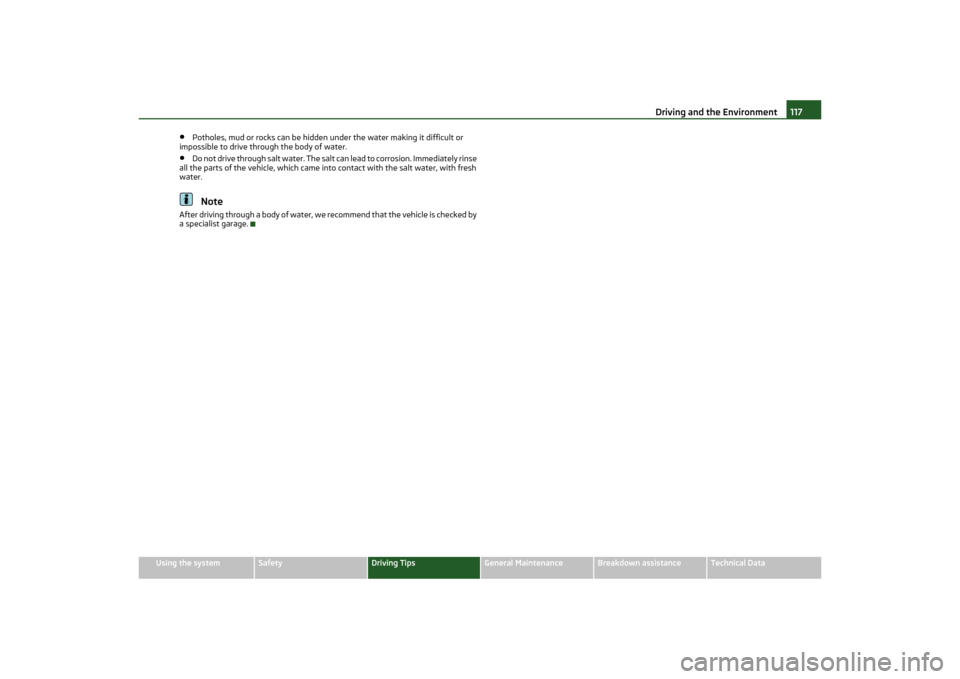
Driving and the Environment117
Using the system
Safety
Driving Tips
General Maintenance
Breakdown assistance
Technical Data
•
Potholes, mud or rocks can be hidden un der the water making it difficult or
impossible to drive through the body of water.
•
Do not drive through salt water. The salt can lead to corrosion. Immediately rinse
all the parts of the vehicle, which came into contact with the salt water, with fresh
water.Note
After driving through a body of water, we recommend that the vehicle is checked by
a specialist garage.
s2lk.2.book Page 117 Monday, April 18, 2011 7:41 AM
Page 119 of 183
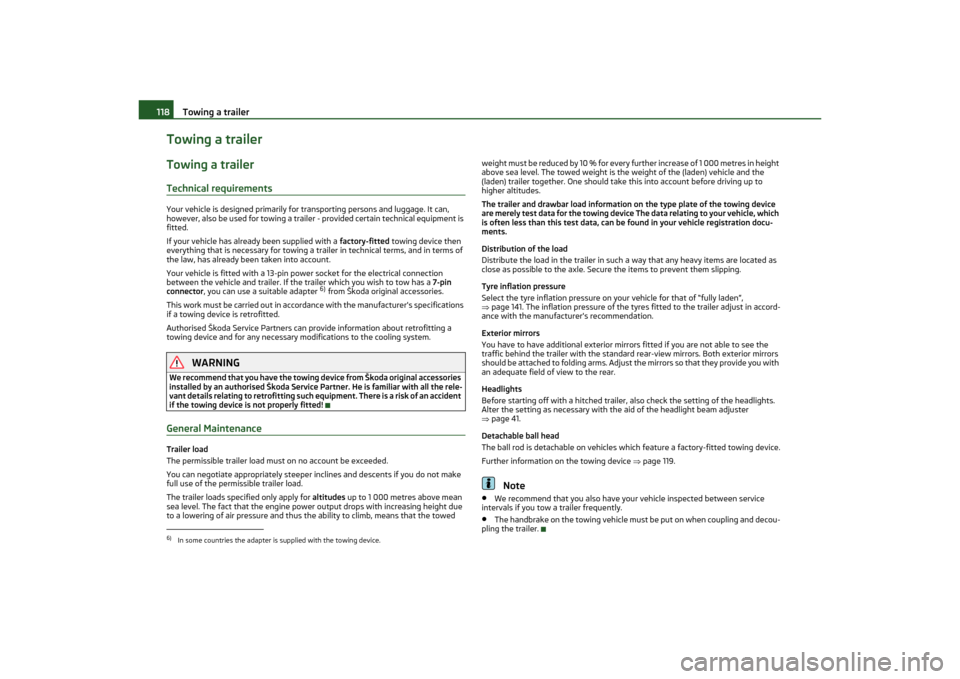
Towing a trailer
118
Towing a trailerTowing a trailerTechnical requirementsYour vehicle is designed primarily for tr ansporting persons and luggage. It can,
however, also be used for towing a trailer - provided certain technical equipment is
fitted.
If your vehicle has already been supplied with a factory-fitted towing device then
everything that is necessary for towing a tr ailer in technical terms, and in terms of
the law, has already been taken into account.
Your vehicle is fitted with a 13-pin power socket for the electrical connection
between the vehicle and trailer. If th e trailer which you wish to tow has a 7-pin
connector , you can use a suitable adapter
6) from Škoda original accessories.
This work must be carried out in accordance with the manufacturer's specifications
if a towing device is retrofitted.
Authorised Škoda Service Partners can pr ovide information about retrofitting a
towing device and for any necessary modifications to the cooling system.
WARNING
We recommend that you have the towing de vice from Škoda original accessories
installed by an authorised Škoda Service Partner. He is familiar with all the rele-
vant details relating to retrofitting such equipment. There is a risk of an accident
if the towing device is not properly fitted!General MaintenanceTrailer load
The permissible trailer load must on no account be exceeded.
You can negotiate appropriately steeper inclines and descents if you do not make
full use of the permissible trailer load.
The trailer loads specified only apply for altitudes up to 1 000 metres above mean
sea level. The fact that the engine power output drops with increasing height due
to a lowering of air pressure and thus th e ability to climb, means that the towed w e i g h t m u s t b e r e d u c e d b y 1 0 % f o r e v e r y f u r t h e r i n c r e a s e o f 1 0 0 0 m e t r e s i n h e i g h t
above sea level. The towed weight is the weight of the (laden) vehicle and the
(laden) trailer together. One should take
this into account before driving up to
higher altitudes.
The trailer and drawbar load information on the type plate of the towing device
are merely test data for the towing device The data relating to your vehicle, which
is often less than this test data, can be found in your vehicle registration docu-
ments.
Distribution of the load
Distribute the load in the trailer in such a way that any heavy items are located as
close as possible to the axle. Secure the items to prevent them slipping.
Tyre inflation pressure
Select the tyre inflation pressure on your vehicle for that of “fully laden”,
page 141. The inflation pressure of the tyre s fitted to the trailer adjust in accord-
ance with the manufacturer's recommendation.
Exterior mirrors
You have to have additional exterior mirr ors fitted if you are not able to see the
traffic behind the trailer with the standard rear-view mirrors. Both exterior mirrors
should be attached to folding arms. Adjust the mirrors so that they provide you with
an adequate field of view to the rear.
Headlights
Before starting off with a hitched trailer, also check the setting of the headlights.
Alter the setting as necessary with th e aid of the headlight beam adjuster
page 41.
Detachable ball head
The ball rod is detachable on vehicles wh ich feature a factory-fitted towing device.
Further information on the towing device page 119.
Note
•
We recommend that you also have your vehicle inspected between service
intervals if you tow a trailer frequently.
•
The handbrake on the towing vehicle must be put on when coupling and decou-
pling the trailer.
6)In some countries the adapter is supplied with the towing device.s2lk.2.book Page 118 Monday, April 18, 2011 7:41 AM